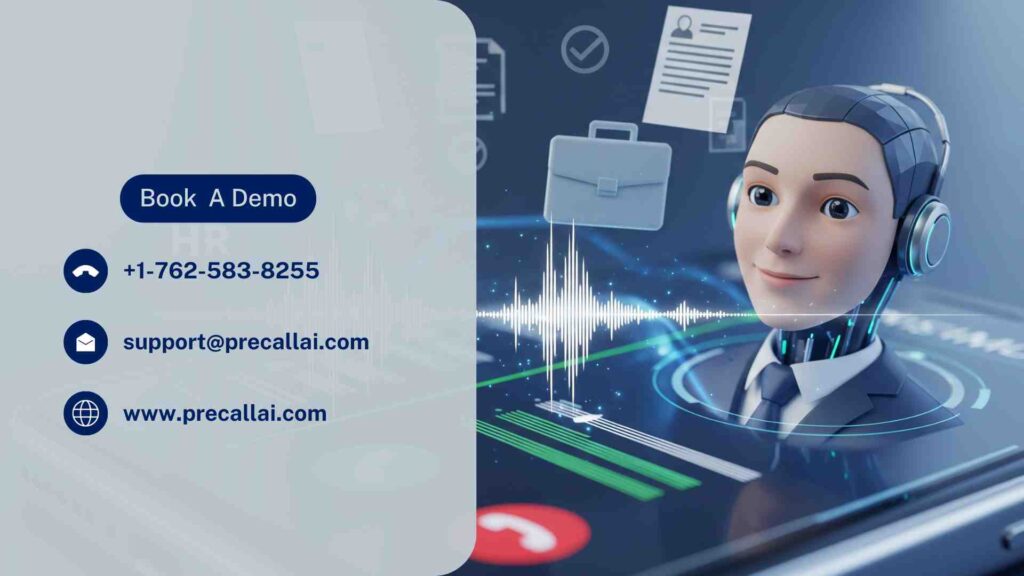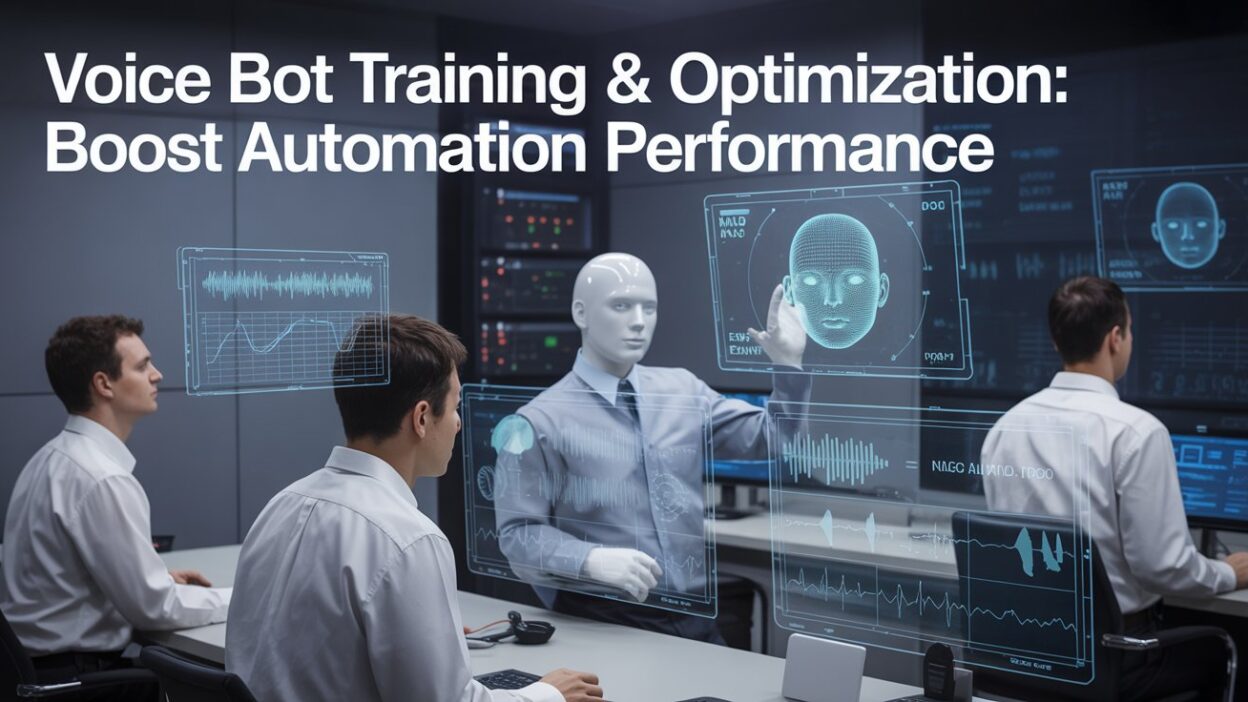Voice bot training & optimization has transformed how businesses interact with customers daily. Companies deploy automated systems to handle calls efficiently around the clock. These intelligent solutions reduce costs while improving service quality significantly.
Table of Contents
Modern voice bots require sophisticated training to perform effectively. Strategic optimization ensures peak automation performance across various scenarios. Businesses gain competitive advantages through well-implemented voice automation systems.
The success of voice automation depends on proper development and refinement. Expert training methodologies create robust conversational capabilities. Continuous optimization maintains superior performance levels over time.
The Fundamentals of Voice Bot Training and Optimization
Voice bot training and optimization encompasses the complete process of developing intelligent phone automation systems. Training involves teaching artificial intelligence to understand and respond to human speech patterns. Machine learning algorithms process vast amounts of conversational data.
The optimization phase focuses on refining system performance through data analysis. Real-world testing identifies areas requiring improvement. Performance metrics guide enhancement decisions systematically.
Training requires specialized datasets containing diverse conversation examples. Audio recordings capture various accents, speaking speeds, and communication styles. Natural language processing converts speech into actionable information.
Optimization cycles continuously improve accuracy and response quality. Analytics platforms track user interactions and satisfaction levels. Feedback loops enable automatic system enhancements.
Core Components of Effective Training Programs
Comprehensive Data Collection
Successful voice automation starts with high-quality training datasets. Audio samples must represent diverse customer demographics and communication patterns. Regional dialects require adequate representation in training materials.
Data collection includes various inquiry types and complexity levels. Simple questions establish baseline functionality requirements. Complex scenarios test advanced reasoning and problem-solving capabilities.
Clean audio recordings produce superior recognition accuracy rates. Background noise reduction improves speech processing quality. Multiple microphone types ensure compatibility across different phone systems.
Representative datasets prevent algorithmic bias in system responses. Age, gender, and cultural variations improve service inclusivity. Balanced training data ensures equitable treatment for all users.
Advanced Speech Recognition Technology
Precise speech-to-text conversion forms the foundation of effective voice automation. Recognition engines must handle varying speaking speeds and volumes accurately. Acoustic modeling adapts to different phone connection qualities.
Language models understand industry-specific terminology and professional jargon. Pronunciation variations require robust recognition algorithms. Real-time processing enables natural conversation flow without delays.
Error correction mechanisms identify and fix recognition mistakes automatically. Context clues help resolve ambiguous words and phrases. Continuous learning improves accuracy through ongoing usage.
Natural Language Understanding For Voice Bot Training and Optimization
Voice bots must comprehend the intent behind customer statements accurately. Natural language processing identifies key information from spoken conversations. Context awareness enables appropriate response generation consistently.
Intent classification categorizes customer requests into actionable categories. Entity extraction identifies specific details within conversation content. Sentiment analysis gauges customer emotional states and satisfaction levels.
Dialogue management maintains logical conversation sequences. Multi-turn interactions require sophisticated state tracking capabilities. Conversation memory preserves important details throughout extended interactions.
Proven Voice Bot Training and Optimization Methodologies
Supervised Learning Approaches
Supervised training uses expertly labeled datasets to teach correct response patterns. Human specialists provide ground truth examples for model learning. Annotation processes require significant expertise and time investment.
Training examples include input-output pairs covering various customer scenarios. Models learn through repeated exposure to correct response associations. Validation datasets test learning effectiveness objectively.
Quality control ensures that training data meets accuracy standards. Expert review identifies potential bias or errors in datasets. Iterative refinement improves training quality progressively.
Reinforcement Learning Strategies For Voice Bot Training and Optimization
Reinforcement learning optimizes behavior through reward-based feedback systems. Voice bots receive positive reinforcement for successful interactions. Poor performance triggers corrective learning mechanisms.
Reward functions align with specific business objectives and customer satisfaction goals. Exploration algorithms help discover improved response strategies. Balanced approaches prevent overfitting to training scenarios.
Simulation environments provide safe testing without customer exposure. Virtual interaction scenarios cover edge cases and unusual requests. Controlled testing prevents poor performance during live deployment.
Transfer Learning Applications
Pre-trained models accelerate development timelines significantly. General language understanding transfers effectively to specific business domains. Fine-tuning customizes models for particular industry requirements.
Domain adaptation techniques adjust models for specialized vocabulary needs. Healthcare applications require medical terminology expertise. Financial services demand a compliance-aware response generation.
Cross-industry knowledge sharing reduces training requirements substantially. Shared model components improve development efficiency. Base models provide starting points for customization.
Strategic Optimization Techniques for Peak Performance
Real-Time Performance Monitoring
Continuous analytics tracks voice bot effectiveness during live customer interactions. Call completion rates indicate successful conversation outcomes. Response accuracy metrics identify areas needing immediate attention.
Customer satisfaction scores measure service quality levels objectively. Average response times ensure acceptable interaction speeds. Error pattern analysis reveals systematic improvement opportunities.
Dashboard visualization provides instant performance insights. Alert systems notify administrators of performance degradation. Automated reporting tracks progress over periods.
Data-Driven Enhancement Strategies
Conversation logs provide valuable insights for ongoing voice bot training and optimization efforts. Failed interactions reveal specific training gaps requiring attention. Successful patterns guide replication strategies across similar scenarios.
Analytics platforms identify trending customer topics and emerging needs. Seasonal usage patterns require adaptive response capabilities. New product launches demand rapid vocabulary updates.
Machine learning pipelines automate continuous improvement processes. Scheduled retraining incorporates fresh data regularly. Deployment automation ensures seamless system updates.
Response Quality Improvement For Voice Bot Training and Optimization
Natural language generation creates more human-like conversational responses. Template systems provide consistent brand messaging. Dynamic personalization enhances individual customer engagement levels.
Personality modeling maintains a consistent brand voice across all interactions. Emotional intelligence triggers appropriate empathetic responses. A professional tone ensures suitable business communication standards.
Response timing optimization prevents awkward conversation delays. Strategic pauses create natural interaction rhythms. Interrupt handling maintains smooth conversation control.
Technical Infrastructure for Voice Bot Success
Scalable Computing Architecture
Voice automation training demands substantial computational resources. GPU acceleration significantly speeds model development processes. Distributed computing architectures handle massive dataset processing efficiently.
Cloud platforms provide flexible resource scaling capabilities. Auto-scaling adjusts capacity based on current training demands. Cost optimization strategies reduce unnecessary infrastructure expenses.
High-availability deployment ensures continuous service operations. Load balancing distributes traffic across multiple system instances. Redundant systems prevent service interruptions.
Integration and Connectivity
API frameworks enable seamless integration with existing business systems. Phone system compatibility ensures smooth deployment processes. CRM connectivity provides customer context during conversations.
Real-time data synchronization maintains current information. Webhook notifications trigger automated workflow processes. Database integration enables dynamic information retrieval capabilities.
Security protocols protect sensitive customer information throughout interactions. Encryption safeguards all audio transmissions. Access controls restrict system modification privileges appropriately.
Overcoming Common Training Challenges
Managing Accent and Dialect Variations
Regional speech patterns present significant recognition challenges. Accent-specific training datasets improve understanding capabilities substantially. Phonetic modeling accommodates diverse pronunciation differences effectively.
Geographic representation ensures inclusive service delivery. Demographic diversity prevents regional service bias. Cultural sensitivity training improves international customer experiences.
Adaptive learning algorithms adjust to individual speaking patterns over time. Speaker recognition enables personalized interaction experiences. Custom vocabulary supports local terminology usage.
Context Management and Memory
Extended conversations require sophisticated context retention capabilities. Memory management systems track important conversation details accurately. State machines maintain consistent dialogue flow throughout interactions.
Multi-intent processing handles complex customer requests effectively. Context switching manages smooth topic transitions. Session management preserves conversation continuity across interactions.
Information persistence enables meaningful follow-up conversation references. Customer history integration provides personalized service experiences. Preference learning improves future interaction quality.
Edge Case Handling
Unusual customer requests challenge standard response patterns significantly. Edge case identification prevents unexpected system failures. Graceful degradation maintains acceptable service quality levels.
Fallback mechanisms handle unexpected situations professionally. Human escalation procedures ensure continued customer satisfaction. Error recovery strategies minimize service disruption.
Comprehensive testing validates edge case handling capabilities. Boundary condition analysis prevents unexpected system failures. Stress testing identifies operational limitations early.
Measuring Optimization Success
Key Performance Indicators
Call resolution rates demonstrate voice bot effectiveness objectively. First-call resolution indicates comprehensive problem-solving capabilities. Customer satisfaction surveys reflect actual service quality levels.
Average handling time shows operational efficiency improvements. Cost per interaction quantifies significant operational savings. Agent escalation rates indicate automation success levels.
User adoption metrics track customer acceptance and satisfaction. Repeat usage patterns indicate positive customer experiences. Preference analysis provides qualitative improvement insights.
Return on Investment Analysis
Cost reduction calculations include agent time savings and operational efficiency gains. Revenue protection prevents customer churn through improved service quality. Scalability benefits support business growth without proportional staffing increases.
Implementation expenses include training, data preparation, and system development costs. Ongoing maintenance covers continuous optimization and improvement efforts. Infrastructure investments account for computing resource requirements.
Financial modeling determines realistic payback period expectations. Sensitivity analysis evaluates various performance scenario outcomes. Long-term projections guide strategic investment decisions.
Future Developments in Voice Automation
Emerging AI Capabilities
Emotional intelligence will enable more empathetic customer service interactions. Advanced personality modeling will create consistent brand experiences. Enhanced contextual awareness will improve conversation relevance significantly.
Multi-modal integration will combine voice capabilities with visual communication elements. Video integration will enhance remote customer service capabilities. Screen sharing will enable guided troubleshooting sessions.
Personalization at Enterprise Scale
Individual customer profiling will customize interaction approaches automatically. Behavioral learning algorithms will adapt to personal communication preferences. Predictive analytics will anticipate customer needs proactively.
Dynamic personality adjustment will match individual customer communication styles. Cultural sensitivity features will ensure appropriate international service delivery. Accessibility enhancements will support diverse customer abilities.
Read More: Gather AI Phone Surveys For Customer Feedback With AI Voice Bots
Conclusion

Voice bot training and optimization represent a strategic investment in customer service automation technology. Proper implementation delivers substantial operational benefits and customer satisfaction improvements. Methodical approaches ensure maximum return on automation investments.
Long-term success requires commitment to continuous improvement and systematic optimization. Regular performance monitoring identifies specific enhancement opportunities. Data-driven decision making guides effective optimization strategies.
Organizations embracing comprehensive voice automation development gain significant competitive advantages. Technology continues evolving to meet changing customer service expectations. Strategic investment in training and optimization ensures sustainable automation success over time.






[…] Read More: Voice Bot Training & Optimization: Boost Automation Performance […]
[…] Read More: Voice Bot Training & Optimization: Boost Automation Performance […]
[…] Read More: Voice Bot Training & Optimization: Boost Automation Performance […]